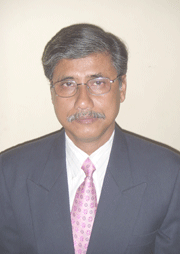E-Archive
MFN Trainer Column
in Vol. 9 - May Issue - Year 2008
Blast Cleaning Principles

MFN Trainer Ananda Talukdar
This column is a regular feature and is written by one of our MFN trainers or the Editorial Office. Readers are invited to send comments or questions to info@mfn.li. For more information about the trainers, see our website www.mfn.li/trainers.
At the very onset, I would like to thank the MFN Team for a warm welcome extended to me as an MFN Trainer. Joining this team gives me an opportunity to share my 25 years of experience in the Shot Peening & Surface Preparation Industry.
The History of Blast Cleaning dates back to 1870 when Mr.B.C.Tilghmaan of Philadelphia obtained the first patent for sand blasting. Since then lot of advances have taken place in this field but largely we find that this process has always been a bottleneck area in many of the organizations. We will try to look into the reasons for such bottlenecks.
Shot Peening and Shot Blasting System is divided into 5 main sub systems:
• blasting unit/ wheel unit
("heart of the machine")
• blast cabin
("skeleton & muscular system")
• abrasive handling system
("blood circulation system")
• separation system
("excretory system")
• dust collection system
("respiratory system")
It is seen that the sub systems behave and function similar to the human systems. Most of the users neglect the separation system and dust collection system. The repercussions are similar to failure of respiratory & excretory systems in human being.
It is important to understand that the separation system and dust collection system contribute 60-70% to the overall efficiency of the machine.
The following are the benefits from a healthy separation system and dust collecting system:
• It can keep the abrasive feeding into the blasting unit free of any dust or sand thereby not only increasing the wear parts life but also improving the productivity. It is a known fact that if 1% or more by weight of sand/dust carried along with the abrasive to the blasting unit the wear parts life reduces by 80%.It further reduces the dust generation in the blast chamber when blasting is in operation thereby not straining the suction from the blast cabinet. The wear parts life of blasting unit increases many times by keeping the dust percentage in the re-circulated abrasive to zero.
• The abrasive removal size controlled within ± 10% without adding any additional sieving equipment thereby increasing the utilization of abrasives.
• It can assess the breakdown rate of abrasive.
• It maintains a proper OPERATING MIX of abrasive.
• It avoids dust accumulation on blasted/peened components.
• It can reduce the cycle time.
• The manual practice of cleaning of carry over abrasive eliminated.
• Not least it makes the equipment user friendly.
In my long experience I have come across several instances wherein users have replaced the machine as the performance has deteriorated. The Root cause has been the lack of knowledge about the significance of separation & dust collecting system. In one of the typical cases, cycle time reduced from 30 minutes to 5 minutes by improving the performance of separator and dust collecting system. So one can appreciate the increase in productivity one can gain by taking the initiative to keep the separator and dust collector healthy.
To conclude in case you want to increase the productivity, reduce downtime of your equipment and want a trouble free shot blasting and shot peening system then keep the separation & dust collection system healthy.
Best Regards
Ananda Talukdar
ananda@mfn.li
Author: Ananda Talukdar



























